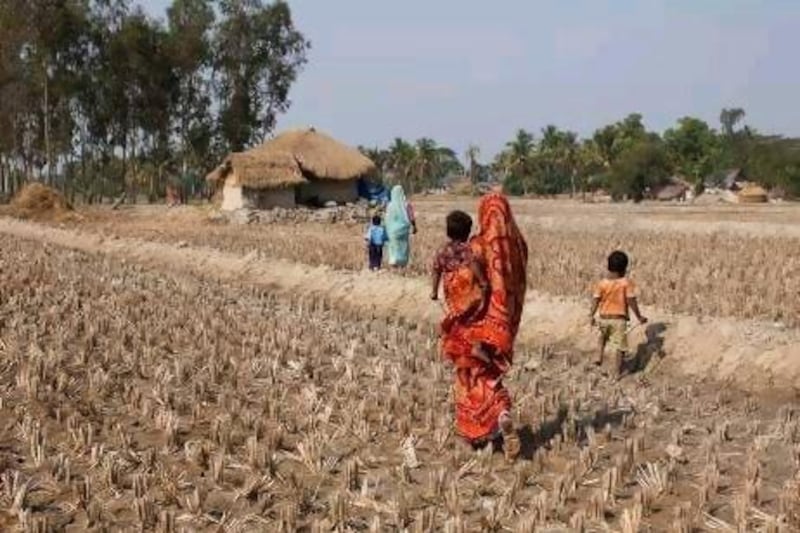Living cheek by jowl with the big cats, Sundarban villagers revere and fear tigers in equal measure. So they should. On average, tigers kill one person every 48 hours in this delta region sandwiched between India and Bangladesh. Suryatapa Bhattacharya, Foreign Correspondent, reports
GOSABA ISLAND, INDIA // In the boat back from the Sundarbans in the vast Bay of Bengal to civilisation, all I can think of is a tiger hiding in the dark water.
Waiting to pull me in.
If a tiger wants me, there is no escape - if I'm quick, maybe I can throw a chicken coop, a bicycle, maybe even a motorcycle - my travelling companions on the boat - between myself and the hungry tiger.
But if the stories of tiger attacks from the villagers of the Sundarbans were anything to go by, probably not.
This is one of the most beautiful and most dangerous parts of the world. The delta where India's main rivers, including the Ganges, spill into the sea between India and Bangladesh. The world's largest mangroves.
It is not unusual to feel terrified in the Sundarbans, a name which translates to "beautiful forest" in Bengali.
The term forest is something of a misnomer. The region is a delta made up of a series of islands and mangrove swamps.
An old villager told me to fall in love with the place is to be terrified by it.
It is a place that carries deep meaning for Indians and Bangladeshis.
It is beautiful, but it is terrifying to live so close to the tiger. That pretty much sums the Sundarbans for me.
When I arrive at a village on one of the damp islands, locals have just finished their daily prayers to Bono Devi, the goddess who protects them from the tiger.
Tigers, on average, kill one person every two days in the jungles, swamps and islands here.
As I land on Gosaba island, trying not to fall into its sticky grey clay banks, I immediately feel how the tiger dominates life in the Sundarbans.
In village tradition, I don't even dare speak its name. People here simply mumble and say: "You can't say that word."
The Sundarbans are woefully underdeveloped. There are dirt tracks that run across the embankments built to keep the islands from flooding during the monsoon. None is wide enough even for a three-wheeled rickshaw.
The only way around is to take a boat between the islands and walk or bicycle or, as I had the money, the luxury of a motorcycle.
Most people here walk for up to three hours to reach the nearest market, hospital or government office, each way.
The villagers have a hundred stories of someone who accidentally poisoned themselves, or cut themselves chopping wood dying needlessly because the hospital was too far away.
To even call it a hospital is a stretch. There is one doctor, so they say. He is rarely ever there.
The villagers are bitter that the tigers receive more attention than they do.
"Beast above man," says one villager, bitterly.
Some take out their frustrations on tourists.
A village head confronts me when I land.
"Are you here to take pictures, sell it to the world and make lots of money?" he snarls. "Does the world even know what the Sundarbans are?"
I am just here to talk and to listen to this man and others like him.
But for the villagers, the world cares more about the few dozen tigers in the thousands of hectares here than it does about them.
There is a saying that if you throw a seed on the ground in the Sundarbans, it will sprout into a tree.
Life is strong here. The fertile ground makes farming easy.
There are bright green rice paddies everywhere. Date palm trees bursting with fruit dot the edges of ponds. The vegetable gardens surrounding every hut in the village were heaving with cauliflower, kohlrabi eggplant and pumpkins.
One of the oldest professions in the Sundarbans is gathering wild honey.
They need permits to go into the jungle. The tiger's territory. "To go hunting is to be hunted by the tiger," a villager tells me
But the risk is worth it. The honey they bring home is some of the best I have tasted.
It has a hint of orange. It's more runny than normal. And it's not cloyingly sweet as some of honey you buy in the stores.
Before I climb back into that rickety machine, an excuse of a boat, the community elders - now welcoming - decide I should take home a souvenir.
They take me to a shop selling the special honey.
The storekeeper kindly brings out the best from the back and I stuff a couple of bottles into my bag.
Of course, when I open my bag in Delhi, my clothes, already caked in dried clay were now covered in a sticky, honey mess.
That is the Sundarbans.
[ sbhattacharya@thenational.ae ]
Follow
The National
on
[ @TheNationalUAE ]
& Surya Bhattacharya on
[ @SuryatapaB ]





